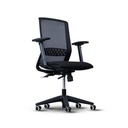Ergonomics is the science of tailoring the workstation and work environment to the user to lower the risk of musculoskeletal strain that can lead to injury and illness. Within every work environment there are different external factors that can affect productivity and work related injury, laboratory work is no different. Whether you work irregularly in the lab or even if lab work is a constant throughout your career there are ways to protect yourself from ergonomic pitfalls and remain efficient.
Laboratory workers are at a high risk of developing cumulative trauma injuries due to the amount of repetitive movements they incorporate into their day like pipetting, the use of small hand held tools, opening and closing vial caps along with prolonged negative postures while at a microscope or similar instruments.
By understanding how to control laboratory ergonomic risk factors, lab workers can improve their level of productivity, comfort and job satisfaction all the while lowering chances for occupational injuries.
General Tips for Laboratory Workers;
It is important to always be aware of your posture in the lab. Incorporate these tips throughout your working day to remain efficient and injury free.
- Vary posture as much as possible. Move between sitting and standing if the task allows.
- Take shorter, more frequent breaks from repetitive tasks or movements.
- If you must stand for long periods, use supportive shoes and cushioned mats.
- Keep your shoulders relaxed and your elbows close by your sides while working. Avoid reaching too much when using instruments.
- Where possible, maintain neutral or aligned wrist and arm postures while working and avoid repetitive or forceful twisting and turning movements.
- Try tilting the seat forward or use a seat wedge to work in a forward position without leaning forward and increasing the likelihood of neck injury.
- If working at a screen, ensure the top third of the screen is at eye level.
When at the Lab bench;
- Ensure bench height is appropriate for work tasks. For precision or more focused work the counter should be above elbow height, for lighter work just below elbow height and for heavy work the counter height should be approximately 6 inches below elbow height.
- Ensure bench edges are padded or covered and there are no pressure points on forearms.
- Keep frequently used items within arms reach if possible to avoid leaning over repeatedly.
- Sit against the back of your chair. If feet are unsupported adjust the height of the chair or the footrest.
- Try and sit as close to the bench as possible. This will eliminate the need for you to lean forward and unload your weight onto the counter.
Although laboratories provide many challenges for those tasked with creating an ergonomic environment, lab workers or researchers don't have to resign to physical issues at some stage during their career. Implement these tips to improve productivity within the lab and limit work related injuries further down the line.
For more information regarding workplace ergonomics or to arrange a Free Consultation with one of our Ergonomic Consultants at our Dublin City Centre Showroom on Clare Street (Near Merrion Square, opposite the National Art Gallery) get in touch on 01 6110200.















